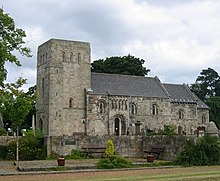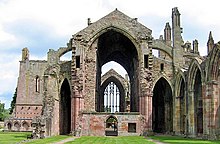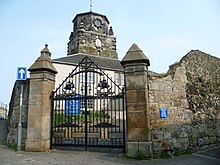Church architecture in Scotland

Church architecture in Scotland incorporates all church building within the modern borders of Scotland, from the earliest Christian structures in the sixth century until the present day. The early Christian churches for which there is evidence are basic masonry-built constructions on the west coast and islands. As Christianity spread, local churches tended to remain much simpler than their English counterparts. By the eighth century more sophisticated ashlar block-built buildings began to be constructed. From the eleventh century, there were larger and more ornate Romanesque buildings, as with Dunfermline Abbey and St Magnus Cathedral in Orkney. From the twelfth century the introduction of new monastic orders led to a boom in ecclesiastical building, often using English and Continental forms. From the thirteenth century elements of the European Gothic style began to appear in Scotland, culminating in buildings such as Glasgow Cathedral and the rebuilt Melrose Abbey. Renaissance influences can be seen in a move to a low-massive style that was probably influenced by contacts with Italy and the Netherlands.
From the mid-sixteenth century the Reformation revolutionised church architecture in Scotland. It resulted in a rejection of the elaborate ornamentation of existing churches. New churches were produced in a plain style, often with a T-plan that emphasised the pulpit and preaching. This style was adopted by both Presbyterian and Episcopalian wings of the Scottish Kirk, but there were some attempts to introduce Baroque elements into church building after the Restoration. In the eighteenth century the influence of James Gibbs led to churches that employed classical elements, with a pedimented rectangular plan and often with a steeple. This classicism continued into the early nineteenth century, but became increasingly controversial and began to be rejected for a version of the Gothic Revival, which flourished into the early twentieth century. Between the world wars, a form of Neo-Romanesque became the norm for new churches. In the second half of the twentieth century new churches were highly influenced by Modernism, resulting in rectangular and irregularly shaped buildings, built in new materials, although many of these were later demolished. As the level of new building reduced from the 1970s there was a move to functional and unambitious new churches, but in the 1980s there was a move back to more striking and original designs.
Middle Ages
Early churches

The introduction of Christianity into Scotland from Ireland from the sixth century led to the construction of the first churches. These may originally have been wooden, like that excavated at
Monasteries also differed significantly from those on the continent, and were often an isolated collection of wooden huts surrounded by a wall.[5] At Eileach an Naoimh in the Inner Hebrides there are huts, a chapel, refectory, guest house, barns and other buildings. Most of these were of timber and wattle construction and probably thatched with heather and turves. They were later rebuilt in stone, with underground cells and circular "beehive" huts like those used in Ireland. Similar sites have been excavated on Bute, Orkney and Shetland.[3] From the eighth century more sophisticated buildings emerged.[2] The development of early ashlar masonry produced block-built stone buildings, like the eleventh century round tower at Brechin Cathedral and the square towers of Dunblane Cathedral and The Church of St Rule.[2]
Romanesque

After the eleventh century, as masonry techniques advanced, ashlar blocks became more rectangular, resulting in more stable walls that could incorporate refined architectural moulding and detailing that can be seen in
Gothic

The style that developed from the Romanesque, originating in twelfth-century France, is now known as

A more elaborate style known as
In the fifteenth century, continental builders are known to have been working in Scotland. French master-mason John Morrow was employed at the building of Glasgow Cathedral and the rebuilding of Melrose Abbey, both considered fine examples of Gothic architecture.[16] Compared with after the Reformation, the interiors of churches were often elaborate, with highly decorated sacrament houses, like the ones surviving at Deskford and Kinkell.[4] The carvings at Rosslyn Chapel, depicting the progression of the seven deadly sins, were created in the mid-fifteenth century. They are considered some of the finest in the Gothic style.[17] Late Medieval Scottish churches also often contained elaborate burial monuments, like the Douglas tombs in the town of Douglas.[4]
Renaissance
The impact of the
Early modern era
Reformation

From about 1560, the Reformation revolutionised church architecture in Scotland. Calvinists rejected ornamentation in places of worship. With no need for elaborate buildings divided up by ritual there was widespread destruction of Medieval church furnishings, ornaments and decoration.[21] There was a need to adapt old buildings and build new churches suitable for reformed services, particularly by putting the pulpit and preaching at the centre of worship.
Many of the earliest buildings were simple gabled rectangles, a style that continued to be built into the seventeenth century. Examples include Dunnottar Castle in the 1580s, Greenock (1591) and Durness (1619),[22] These new buildings often had windows on the south wall and none on the north, which became a unique feature of Reformation kirks. There were continuities with pre-Reformation materials, with some churches using rubble, as at Kemback in Fife (1582). Others employed stone and a few added wooden steeples, as at Burntisland (1592).[23] The church of Greyfriars, Edinburgh, built between 1602 and 1620, used a rectangular layout with a largely Gothic form, but that at Dirleton (1612), had a more sophisticated classical style.[22]
A variation of the rectangular church that developed in post-Reformation Scotland was the T-shaped plan, often used when adapting existing churches, which allowed the maximum number of parishioners to be near the pulpit. They can be seen at Kemback and
Restoration
By the later seventeenth century both the Presbyterian and episcopalian wings of the church had adopted the modestly sized and plain form of churches that had emerged after the Reformation.
Eighteenth-century Neo-Classicism

In the eighteenth century established patterns continued, with T-shaped churches with steeples on the long side, as at New Church, Dumfries (1724–27), and Newbattle Parish Church (1727–29). William Adam's Hamilton Parish Church (1729–32), was a Greek cross plan inscribed in a circle, while John Douglas's Killin Church (1744) was octagonal. Scots-born architect James Gibbs was highly influential on British ecclesiastical architecture. He introduced a consciously antique style in his rebuilding of St Martin-in-the-Fields, London, with a massive, steepled portico and rectangular, side-aisled plan. Similar patterns in Scotland can be seen at St Andrew's in the Square (1737–59), designed by Allan Dreghorn and built by the master mason Mungo Nasmyth, and at the smaller Donibristle Chapel (completed 1731), designed by Alexander McGill. Gibbs' own design for St. Nicholas West, Aberdeen (1752–55), had the same rectangular plan, with a nave-and-aisles, barrel-vaulted layout with superimposed pedimented front.[26] After the Toleration Act of 1712, episcopalians began building a limited number of new chapels including Alexander Jaffray's St Paul's chapel in Aberdeen (1721), the meeting house designed by McGill in Montrose, an Edinburgh chapel opened in 1722 and St Andrew's-by-the-Green in Glasgow (1750–52), which adopted a simpler version of Gibbs' pedimented rectangular plan.[27]
In the second half of the eighteenth century, Scotland's rapidly expanding economy and population resulted in the laying out of numerous
Nineteenth century
Neo-Classicial decline

In the early nineteenth century the Gibbs-influenced steepled tradition continued, as can be seen in
Gothic Revival
As elsewhere in Western Europe, in the nineteenth century there was a return to Medieval styles, grouped together into a Gothic revival. Early examples included Adams' St George's Episcopal Chapel in Edinburgh (1792), which included octagonal lantern on

As urban populations grew, major Neo-Gothic churches were built to accommodate them. After the passing of the
The Kirk began to concern itself with providing churches in the new towns and relatively thinly supplied Highlands, establishing a church extension committee in 1828. Led by
The intense competition for congregations also led to changes to make worship more attractive that were reflected in architecture.
A sub-set of the Medieval revival were
The Gothic style developed fully in the later nineteenth century.
Twentieth century
Neo-Romanesque
In the first half of the twentieth century, there continued to be isolated examples of Gothic church building, including L. G. Thomson's

The reunification of the Church of Scotland in 1929 removed much of the need for new Presbyterian church-building, which was replaced by a tendency towards renovating nineteenth-century churches, toning-down ritualistic furnishings; replacing dark varnish by white or neutral colour schemes. The main tendency in church design in the 1930s was a move towards classicism. There were isolated large classical Protestant commissions, such as Bristo Baptist Church, Edinburgh (1933–35), but the major buildings in this form were in the Catholic Church where there was a movement towards worshipper-centred basilican plans, after the pontificate of
The leading figure in pursuing this style was Giacomo Antonio (Jack) Coia, who after the deaths of his partners, was the sole heir to the Glasgow-based practice of
Modernism and Post-Modernism

After the Second World War, there was another period of rapid church building, as the creation of new towns and
The Catholic Church, whose traditional membership was most affected by the changes in housing, was the first to react to this situation, creating 76 new parishes between 1845 and 1960 in the west of the country alone. The Baptist and Episcopalian churches followed close behind, particularly in the new towns.[41] Within the Church of Scotland, the closeness of congregation and clergy was expressed in the domestic plainness of 1950s dual-use hall churches, as at Reiach's Kildrum Parish Church, Cumbernauld (completed 1962), a steel framed building, clad in timber and brick with a flat roof.[43] Of 129 buildings erected by the Church of Scotland between 1948 and 1959, 108 were on this basic pattern.[41]
The influence of more radical Expressionism and Modernism can be seen in buildings such as Basil Spence's Mortonhall Crematorium, Edinburgh (1964–67), with a series of irregular chapels, with smooth-faced blockwork and Wheeler & Sproson's Boghall Church, Bathgate (1965), influenced by Beaux-Arts architecture.[43] The pioneering contribution from the Church of Scotland was St. Columbia's, Glenrothes (1960), which had seating for the congregation on three sides of a central platform, with the choir and elders on the fourth side behind the pulpit.[44]

In the Roman Catholic Church, the most important steps towards an
The end of this phase of church-building, as the production of new housing subsided in the 1970s, saw a return to conservatism in church design, which may have reflected a loss of confidence in the churches as attendances rapidly declined.[42] M. Glendinning, R. MacInnes and A. MacKechnie have identified a "post-Coia" style emerging in this period.[46] The limited building, some replacing existing churches, tended to be by building companies using laminated timber beams, exposed brickwork and pyramidal roofs to produce utilitarian, if aesthetically unadventurous, constructions.[42] From the late 1980s there were some original designs, including St Mary the Virgin, in Port Glasgow (1984) by Frank Burnet, Bell and Partners; St Anthony's Catholic church in Kirriemuir (1987), by James F. Stephen Architects; and the replacement church at St Joseph's Catholic Church, Faifley (1997) by Jacobsen and French.[42] There was also the postmodern design of St John Ogilvie Catholic Church, Irvine (1982),[46] and the nearby Girdle Toll parish church, converted from a farmhouse (1992).[42]
Notes
- ISBN 0-7486-2179-2, p. 1.
- ^ ISBN 1-904320-02-3, pp. 22–3.
- ^ ISBN 0-85263-748-9, p. 8.
- ^ ISBN 0-415-02992-9, p. 117.
- ISBN 0-88920-166-8, pp. 77–89.
- ^ ISBN 0-85263-748-9, p. 10.
- ISBN 1-111-83168-8, p. 270.
- ISBN 0-85263-748-9, p. 11.
- ISBN 0-85263-748-9, p. 12.
- ISBN 0-85263-748-9, p. 13.
- ^ ISBN 0-85263-748-9, pp. 12–14.
- ISBN 0-7509-2977-4, p. 122.
- ISBN 0-85263-748-9, pp. 15–16.
- ISBN 0-85263-748-9, pp. 32 and 49.
- ISBN 0-85263-748-9, p. 32.
- ISBN 0-7486-0276-3, pp. 57–9.
- ISBN 0-631-21785-1, p. 532.
- ISBN 0-7486-0849-4, pp. 3–4.
- ISBN 0-19-162433-0, p. 190.
- ISBN 0-19-162433-0, p. 188.
- ^ Royal Institute of British Architects, Kirks throughout the ages, architecture.com, archived from the original on 14 October 2007, retrieved 13 January 2010
- ^ ISBN 0-415-16357-9, p. 517.
- ISBN 0-7190-5487-7, pp. 53 and 57.
- ^ ISBN 0-7486-0849-4, p. 141.
- ^ ISBN 1-85158-295-9, pp. 62–7.
- ^ ISBN 0-7486-0849-4, p. 143.
- ISBN 0-7486-0849-4, pp. 143–4.
- ISBN 0-7486-0849-4, p. 176.
- ISBN 0-7486-0849-4, p. 181.
- ^ ISBN 0-7486-0849-4, p. 234.
- ISBN 0-7190-4020-5, pp. 17–18.
- ^ ISBN 0-19-162433-0, p. 95.
- ISBN 0-7546-5797-3, pp. 128–9.
- ISBN 0-7486-0849-4, pp. 234–5 and 302.
- ISBN 0-85263-748-9, p. 118.
- ^ ISBN 0-7190-4020-5, pp. 108–10.
- ISBN 0-7486-0252-6, pp. 209–12
- ISBN 0-415-05307-2, pp. 175–83.
- ^ ISBN 0-7486-0849-4, p. 418.
- ISBN 0-7486-0849-4, p. 417.
- ^ ISBN 0-7486-0886-9, p. 164.
- ^ a b c d e J. R. Hume, "Post-War Churches In Scotland: Breaking The Mould", Scotland's Churches Trust, retrieved 29 December 2012.
- ^ ISBN 0-7486-0849-4, pp. 471–2.
- ISBN 0-7546-5797-3, p. 156.
- ISBN 0-7486-0849-4, p. 475.
- ^ ISBN 0-7486-0849-4, p. 487.
